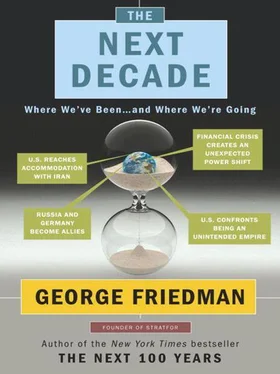Afghanistan provided the illusion of an invasion, but what really happened was the resumption of a civil war, backed by American air power. The fighting that began a month after September 11 was done primarily by Afghans, supported by air strikes from carriers and bombers based in the Persian Gulf and the Indian Ocean. But rather than massing in front of the major cities and becoming targets to be bombed by B-52s, the Taliban, in classic insurgent fashion, dispersed, then regrouped later to resume the battle.
As a result, the Taliban was never actually defeated, but the United States did achieve three of its goals. First, it reassured the American public that it was able to protect them by mounting military action anywhere in the world. This wasn’t altogether true, but it was true enough to be comforting. Second, it signaled to the Islamic world that the United States was absolutely committed to the conflict. More sophisticated than the American public, Muslim leaders noted that the major American contribution was air power, while the heavy lifting was done by the Afghans. This was not definitive evidence of American commitment; it was, however, better than no action. Third, the action inflicted damage on al Qaeda. Bin Laden and others escaped, but their command-and-control structure was disrupted, which forced the leaders to become fugitives. As a result, they became increasingly isolated and largely irrelevant.
Afghanistan was in some ways a sleight of hand, but it achieved what could be achieved. The United States had launched a disruptive spoiling attack—a classic American maneuver. The Bush administration installed and protected a government, knowing that most of Afghanistan was outside its reach and that creating a democracy there was not in the cards. Nine years later, Afghanistan is still far from resolved, and it will certainly be the problem that has to be solved in order to move ahead in the next decade.
From al Qaeda’s point of view, however, U.S. actions in Afghanistan and elsewhere in the Middle East served as clear evidence for Muslims that the United States was their enemy. The jihadists waited for uprisings and toppled regimes—an upheaval that never came. The regimes survived, partly because the Islamic street, as it was called, feared that the security apparatus of their regimes was still brutally effective, and partly because these regimes continued to hedge their bets. They read the U.S. spoiling attack for what it was and held back their own commitment. Both Saudi Arabia’s and Pakistan’s intelligence sharing remained limited, as neither wanted to commit itself to the United States without clear signs of how far the U.S. was prepared to go. As it became clearer that there would be no uprisings, al Qaeda became more aggressive in the region.
The next venture in the U.S. war on terror was the assault on Iraq in 2003. It is easy to argue today that the invasion was an unqualified mistake, but it is important to recall the context in which the decision to invade was made. In February 2002, the Saudis ordered American forces off their soil. The Pakistanis, in spite of heavy pressure from both India and the United States, made only modest gestures of commitment in support of the American effort. The general perception was that the United States had done what it was going to do in Afghanistan and was now hoping that other nations would carry the burden for it, both in intelligence and in operations.
Without the full cooperation of the Saudis and Pakistanis, the United States had limited options. It could conduct an intelligence war against al Qaeda, as the Israelis had done with Black September in Europe in the 1970s; but without contributing partners in the region, the U.S. intelligence capability against al Qaeda was extremely constrained.
A second option was for the United States to move into a purely defensive mode, relying on Homeland Security while hoping that the Afghan operation had disrupted al Qaeda’s command structure enough to prevent new attacks. Theoretically, the FBI could round up sleeper cells while the borders were protected from infiltration and airports secured against terrorists. Attractive on paper, this plan was impossible in practice. The FBI could never guarantee that there were no more sleeper cells in the country, and points of entry into the United States could never be completely secured. Any illusion of safety this effort gave the American public, and any support it might buy the president for a job well done, would last only until the next terrorist attack, the timing and nature of which were completely unknown. When such an attack came, the question of America’s willingness to assert itself and take risks in the Muslim world would surface again, with no clear answer. After Afghanistan, what?
The Bush administration tried to craft a strategy that forced the Saudis and Pakistanis to be more aggressive in intelligence gathering and sharing and that placed the United States in a dominant position in the Middle East, from which it could project power.
These were the underlying reasons for the invasion of Iraq. The military action had the immediate result of creating a new strategic reality. It intimidated Saudi Arabia in particular, placing U.S. armor a few days’ drive from Saudi oil fields. It also gave the United States control of the most strategic country in the region, Iraq, which borders on Kuwait, Saudi Arabia, Jordan, Syria, Turkey, and Iran. So controlling Iraq achieved the short-term goals of the war on terror, but it violated the principle that the United States does not become a permanent player in any region. The Bush administration had wagered that it could sacrifice this part of U.S. strategy—maintaining regional balances of power through surrogates while holding U.S. forces in reserve—in return for other benefits. It was a bad choice on a menu of worse choices, a point that has to be remembered when we consider the nature of imperial power: it may feel compelled to act even when all options are flawed.
Obtaining those benefits, however, required the United States to succeed not just in invading but in pacifying Iraq. The invasion succeeded, without a doubt, and the Saudis markedly increased their cooperation on intelligence. But dominating the most strategic country in the region turned out to be impossible. U.S. forces, having rolled into Baghdad with ease, found themselves quickly tied down in an insurgency that required them to focus all their force inward, when the intent had been to use Iraq as a base from which to project force outward.
This failure of the occupation transformed the war. Iraq became an end in itself, and the ultimate goal became not the creation of a new strategic reality in the region but simply the withdrawal of U.S. forces within a reasonable time frame. The best hope was to leave behind a neutral government; at worst, the end result of the invasion would be chaos.
Iraq became decoupled from America’s broader strategy and became a case study in the relationship among morality, strategy, and leadership. From a purely moral point of view, eliminating the Saddam Hussein regime could hardly have been faulted. He was a monster and his regime was monstrous. But that was not the moral imperative to which Bush had committed his presidency. His stated moral imperative was to wage a war on terror, and the occupation of Iraq made sense to the American people only to the extent that it served that goal.
In deciding to invade in 2003, George W. Bush placed his moral obsession above the fundamental principle of American strategy: maintaining a balance in each region without committing substantial numbers of troops. There are many regions, and if the United States began deploying occupation forces in each of these, the burden would quickly outstrip American capacity. Moreover, U.S. forces had supplanted Iraq’s own forces as the counterweight to Iran, now the largest indigenous power in the region. If at some point the United States simply withdrew from Iraq, Iran would by default dominate the entire Persian Gulf. Whatever the invasion contributed to the war against al Qaeda, the strategic costs of Iraq became too high.
Читать дальше












